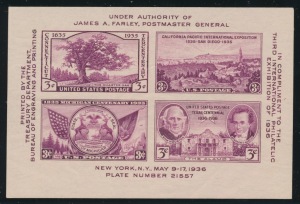Stamps were a hot hobby in the 1930s, and how hot is best illustrated by the fate of two United States Souvenir sheets that were issued three years apart. When the APS sheet was issued in 1933, the hobby was just beginning its Great Depression ascent. The face value of the sheet was only 12¢, but quantities were not saved. When collectors began to demand the sheet, the stocks that dealers had on hand were soon exhausted, and prices rose rapidly. Today, it catalogs $32.50. By the time the 12¢ TIPEX souvenir sheet was issued three years later, collectors and dealers were putting away big stocks of each new issue, and this stamp was one of many from the mid to late 1930s that got put away. Today, with the same face value as the earlier sheet, it catalogs only $1.75. Even today, nearly 80 years later, quantities of thousands exist that have never been in collections and which have been bundled up in groups and still reside in dealer stocks.
In every field, investments are good directly to the extent of how few people are investing in them, and this is especially true in stamps. Very few US stamps issued after 1940 sell today on the wholesale market for even face value, and that's for issues that are over 70 years old. The reason is that beginning about 1935 large numbers of US collectors began to put away quantities of each new issue. The demarcation point, where this began, is nowhere better illustrated than in the history of these two sheets. The expectation of those early investors who bought them was that the hobby would continue to grow and that there would be increasing demand for the stamps that they put away. This didn't happen for three reasons. First, stamp collecting was an increasingly popular hobby for many years, but even in its best years never attracted the hundreds of thousands of new adherents annually that would have been required to raise the price of all those mint stamps that had been saved. Second, philately responds immediately to price changes. When prices of mint US rises quickly, collectors move to used stamps, or to another country, or (and I know this sounds sacrilegious) even a different hobby. This moderates the rise in price of older stamps. And third, in the last thirty years the amount of new mint material issued by the Post Office each year has sucked up an enormous amount of collector money, leaving relatively little for older stamps. Always remember that, though many philatelists make a fine financial profit from their hobby, it is usually the case that this has been a byproduct of a lifetime of pleasurable collecting. The financial success of pure investment philatelists has been more problematic.

